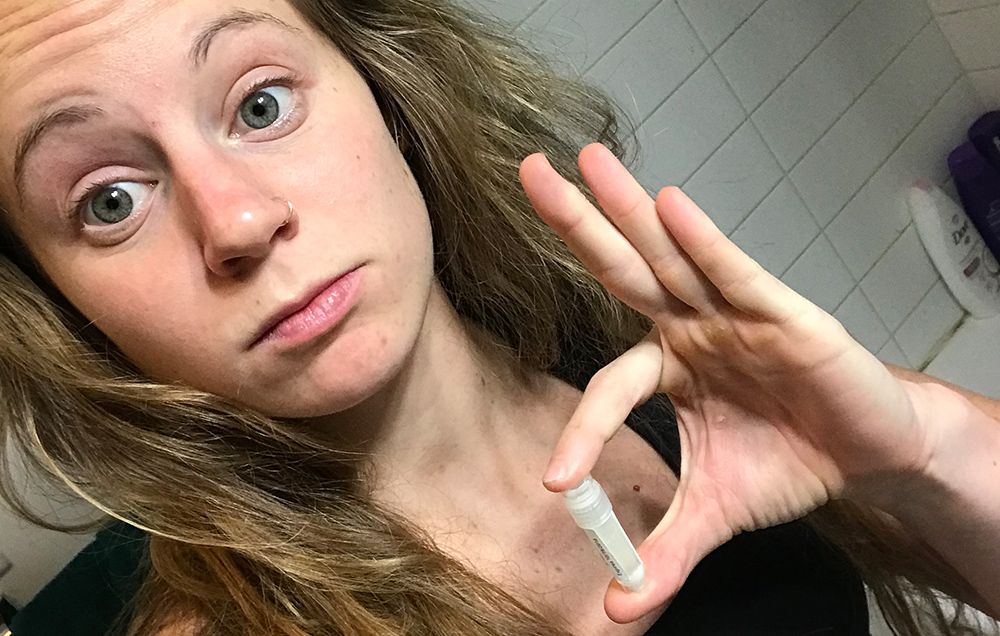No one necessarily wants to discover any kind of rash, bump, redness, itching, or swelling around their vagina—but if you do, it’s normal to feel concerned. I mean, it’s a sensitive area, to say the least, and dealing with discomfort down there isn’t fun.
But there’s no need to panic if your vagina and/or vulva is irritated. There are a ton of reasons this can happen, and plenty you can do to find relief. The one thing you don’t want to do is ignore the issue—and if you’re here, you’re already taking the first step to figure out what’s going on.
Here’s the deal: Sometimes, a rash on the vulva can be caused by something as simple as using a new detergent or chafing from your underwear, but in other cases, it can be a sign of a couple different kinds of infections, and in that case, you definitely want to talk to your health care provider to know for sure what’s up.
No matter the issue at hand, how it progresses is a key indicator of how serious it is, saysJessica Shepherd, MD, ob-gyn and Women’s Health advisory board member. If you’ve noticed a chance in the typical look or smell of your vulva area, monitor the progress of it—if it’s going away on its own, it’s probably nothing major, but if it’s causing you more irritation than when it started, it’s time to talk to your doc.

There are a few possible culprits of a rash or bumps near your vagina, experts say, and some may have more distinct symptoms. These are some of the most common potential causes for vaginal rashes, and how you can treat the irritation and avoid it in the future.
If you recently waxed or shaved, it’s likely contact dermatitis.
The most common cause of a rash on the vulva, Dr. Shepherd says, is contact dermatitis (and research has found that about 50 percent of rashes near the vagina are contact dermatitis-related). Typically, it’s waxing or shaving that can cause folliculitis (a form of irritation from ingrown hair follicles) that’s to blame for contact dermatitis.

Other cases of contact dermatitis may happen from friction from your underwear or clothing, especially if you’re working out frequently and not changing your underwear immediately afterward. It’s just as likely that the rash could be chemical irritation from using a different detergent on your laundry than normal, Dr. Shepherd adds.
During your period, wearing the wrong size pads or tampons, or leaving them in too long, could be a culprit of a rash or redness down there. It can also happen if you have bladder leakage, especially postpartum. “Urine that leaks between pads and underwear can irritate the vulva because it traps moisture,” Dr. Shepherd says. Keeping the skin around the vagina clean and dry can help you avoid contact dermatitis.
Contact dermatitis will be mild in many cases, and the rash can clear up on its own. If it’s severe and persistently painful, Dr. Shepherd suggests checking in with your ob-gyn to have it evaluated.
If you have irritation accompanied by odor or discharge, it may be a bacterial infection.
Infections like bacterial vaginosis (BV) usually aren’t associated with a full-on rash, but there might be pain and swelling involved that change the way things look in the area around the vagina. Another clue might be a thick discharge and abnormal odor. It occurs when there’s an overgrowth of normal bacteria in the vagina, Dr. Shepherd explains.
If you think you might have BV, it’s best to give your doctor a call to do some testing and rule out an STI or other infection, says Dr. Shepherd. Some BV infections are treated by antibiotics, but you need a prescription from a doctor to get them.
If there’s itchiness, redness, and burning, especially during sex, it could be a yeast infection.
Like bacteria, yeast is normally found in the vagina, but a pH imbalance can throw things off and cause an overgrowth of it. Yeast infection symptoms can include vaginal burning, swelling, and thick discharge.

Yeast infections don’t always cause a rash, but it’s possible they will, Dr. Shepherd says. You may experience intense itching, redness of the labia and skin around the vagina, and burning, either after peeing or after sex.
You may be able to treat it with an over-the-counter antifungal treatment, but it’s ideal to check in with your gyno before you do (especially if you’ve never had yeast infections in the past), so they can make sure you get a treatment with the right strength to nix the infection.
If you’ve recently had unprotected sex, there’s a chance it’s an STI.
Every STI is slightly different and has a different treatment plan. But if the rash you’re experiencing is new and causing quite a bit of irritation, it should be checked out, particularly if you’ve had unprotected sex with partners who might be STI-positive. And, if you see your ob-gyn, they can rule out other infections first before running the full panel of STI testing.
Here are the possible STI infections that might be causing that rash:
- Herpes. The first time you experience a herpes rash, it can be very painful, even to sit down or to pee, Dr. Shepherd says. One symptom of genital herpes is tiny little blisters on the vulva or near the crease of your underwear.
- Syphilis. This will cause lesions, but they are not typically painful like a herpes outbreak, explains Dr. Shepherd. Other syphilis symptoms might be rashes appearing on other parts of your body, too.
- Scabies. A scabies infection will involve severe itching, but a smaller rash, Dr. Shepherd says. It won’t be as painful as herpes, mostly just uncomfortable.
- Pubic lice. Just like head lice, pubic lice will cause extreme itching and irritation, Dr. Shepherd says, but higher up than the vagina, in the pubic hair.
If the rash is very red and inflamed, it could be psoriasis.
It’s definitely less common to see a rash near the vagina that can be attributed to psoriasis. But if you already have the condition, there’s at least a 30 percent chance you could develop a genital psoriasis rash, according to the National Psoriasis Foundation—and it will be very uncomfortable (think inflammation and redness to the max).


You’ll likely have other breakouts of psoriasis elsewhere on your body, too. The rash will have lots of lesions, Dr. Shepherd says, and there are not many topical agents or salves that will help it to calm down.
If you have a severe case of psoriasis, a doctor may prescribe you certain oral medications. But it’s best to see a dermatologist, particularly if you haven’t yet been diagnosed with psoriasis.
There are some at-home remedies for a rash on the vulva.
Minor rashes, especially from contact dermatitis, can be treated at home easily and might even dissipate on their own. Actually, the best form of treatment is leaving the area alone and keeping it dry, Dr. Shepherd notes. Although you might want to turn to creams or lotions to stop the itching, they actually might make the rash more irritated (especially if they contain fragrance).
Keep moisture away, especially if you work out or swim often, by changing out of your sweaty clothes or bathing suit right away, Dr. Shepherd suggests. And at night, air things out by going commando, she adds. And while you have the rash, you might want to take a break from shaving or waxing (especially if you suspect that’s what caused it in the first place).
When in doubt, don’t hesitate to check in with your doctor.
If your vulva is consistently irritated, or the rash is getting more painful, give your ob-gyn’s office a call, Dr. Shepherd says. Most likely, your doctor will have you come in for an appointment.
During the visit, your gyno will start by figuring out when the rash started appearing, and if it’s something you’ve ever experienced before. The checkup will continue with an exam of the perineum and any areas you wouldn’t be able to see on your own.
The doctor will examine the vagina through a speculum to check for discharge and inflammation, and may take vaginal swabs to test for infections. If there are visible lesions on the vulva, your doctor can take swab samples from those to test too, Dr. Shepherd says.
Typically, Dr. Shepherd explains, your doc will be able to identify a BV or yeast infection right away. If they’re concerned about a possible STI, it’ll take two or three days to get your results back.
Here are a few things to keep in mind to avoid rashes in the vagina region.
Since so many rashes stem from irritation of the area, make sure you’re always wearing clean undies, especially after a workout. That’s especially important during your period—make a point to change tampons or pads frequently, and wear the appropriate size pad or tampon for your flow so that you’re not adding extra friction from moisture into the mix.


Dr. Shepherd also advises being extra careful when shaving or waxing: Always use a sharp razor to avoid razor burn. If you get waxed, apply aloe to the area afterward to soothe the skin and decrease ingrown hairs.
Diet can play a role in your vaginal health as well. “If you eat a lot of sugary foods and carbs, those can create environments that increase BV risk, for example,” Dr. Shepherd says, so cutting down on added sugar may be beneficial if you’re getting BV or yeast infections frequently.
Above all, pay attention to your body’s normal state, Dr. Shepherd says; that way, you’ll be clued in if anything seems different than usual and can start treatment right away.
Source: Read Full Article
